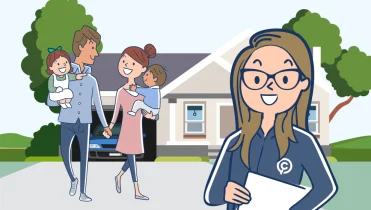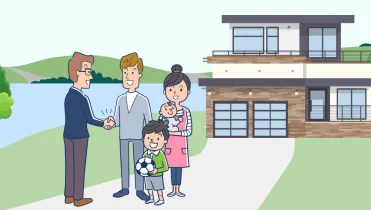quote
- Home
- Home Loans
- Guide
- How do Reverse Mortgages Work?
How Do Reverse Mortgages Work?
Key Points
You remain the owner of your home.
You can continue to live in your home.
No repayments are required.
Your reverse mortgage is repaid when your property is sold.
As with any loan, it’s a good idea to get independent financial or legal advice before you take out a reverse mortgage.
Reverse mortgages are the most popular form of home equity release for retirees. A reverse mortgage allows you to draw on your home equity to improve your retirement income. You don’t need to make regular repayments and you can continue to live in your home.
Not all lenders offer reverse mortgages, as it's a specialised home loan product. Speak to a home loan broker if you're looking to refinance to a new lender.
Enquire TodayWhat is ‘home equity’?
'Home equity' is the value of your home, less any money you owe on it (i.e. what your home is worth, minus the amount of your mortgage).
What is a reverse mortgage?
A reverse mortgage lets you access some of your home equity, while you continue to live in your home. For example, you may want money for medical expenses or to help with your living costs.
Get key information on reverse mortgages in our fact sheet here
Learn more about home loans with these guides
How reverse mortgages work:
A reverse mortgage allows you to borrow money using the equity in your home as security.
If you're aged 55 or over, the most you can borrow is around 15-20% of your home’s value. As a guide, add 1% for each year you're over 55 years old. So, at 65 years of age, the most you can borrow will be about 25-30% of the value of your home.
The minimum loan amount varies by lender, but reverse mortgage minimum loan amounts typically start at about $10,000. Depending on your age and your lender's policies, you’re able to receive your borrowed amount as a:
regular income stream,
line of credit,
lump sum, or a
combination of the above.
What’s the difference between a reverse mortgage and a regular home loan?
As with any standard home loan, a reverse mortgage is secured by registering a first mortgage over your property.
The primary difference between these two types of mortgages is that a reverse mortgage doesn’t require you to make regular loan repayments. Your monthly interest compounds over time and increases the balance of your loan, unless you choose to make interest repayments.
At the same time, you remain the owner of your home and reap the full benefit of the growth in value of your home over time.
If I don’t have to make any monthly repayments, how does my reverse mortgage get repaid?
Your full loan balance is paid off once you no longer need your property (i.e., when you die, or move out permanently - for example, into a nursing home or respite care).
Your home loan is repaid in full, including any accumulated interest and fees, when:
you sell your home,
you move out of your home, or
your deceased estate sells your home.
You're also protected from your property falling into negative equity.
What is negative equity protection?
Negative equity happens when you owe more on your home than it’s worth, which means your debt cannot be fully repaid, even when your home is sold.
Any reverse mortgage taken out after 18 September 2012 has negative equity protection. This means you won’t end up owing your lender more than your home is worth.
If you took out a reverse mortgage before this date, check your loan contract. If it doesn't include negative equity protection, speak to an expert at Compare Club because you may still have options.
Enquire TodayCan I move out of my home if I want to?
Yes, you can move out of your home after you’ve taken out a reverse mortgage - but be aware that once you move out permanently, your entire loan balance may become payable within a shorter time frame than you may have originally expected (usually 12 months).
How much does a reverse mortgage cost?
The cost of a reverse mortgage varies from borrower to borrower. Major influencing factors include:
how much you’re borrowing,
how you’re borrowing it (e.g., a lump sum payment costs more to borrow than smaller regular monthly amounts, due to the compounding interest charges),
the interest rate and fees you’ll be charged (such as your loan establishment fees, ongoing account keeping fees, valuation costs, etc),
how long you intend to hold your loan.
It definitely pays to talk to an experienced broker before taking out a reverse mortgage.
Do I have to sell my home at the end of my loan term?
Not necessarily. If your reverse mortgage is all paid out, then your property becomes debt-free again.
Many reverse mortgage holders find their families are happy to assist with final payouts, keeping their home in the family. There may be additional fees attached to paying out your reverse mortgage earlier. This information will be in your loan contract, and must be taken into account when you're doing your sums.
What's new in home loans - May 2025
RBA rate drop: The RBA cut the cash rate by 0.25% in May, now sitting at 3.85%. This is only the second time rates have been lowered since the hikes began in May 2022.
Cheaper to borrow: Lower rates can reduce variable repayments and boost your borrowing power.
Fixed rate ending? Now’s a good time to speak with a broker at Compare Club about your next steps.
What are the benefits of a reverse mortgage?
Here are a few things to consider before taking out a reverse mortgage:
Reverse mortgage interest is calculated on your daily outstanding balance, and added monthly to your loan account, meaning your loan balance increases over time.
The amount of equity you can draw down is determined by your age, property value, and other loan approval criteria.
Drawing funds from your property now, reduces what you could potentially access later on.
Variable interest rates mean that there will be changes to what you're charged over time.
There are fees and charges for setting up your loan, depending on what options you select, so you’ll want to ensure these set-up costs remain within your budget.
Things You Should Know
This guide is opinion only and should not be taken as financial advice.The information contained on this web page is of general nature only and has been prepared without taking into consideration your objectives, needs and financial situation. You should check with a financial professional before making any decisions. Any opinions expressed within an article are those of the author and do not specifically reflect the views of Compare Club Australia Pty Ltd.
Anthony Stevenson, is the head of home loans at Compare Club. With over a decade of experience under his belt, Anthony is dedicated to helping individuals make informed decisions when choosing a home loan. Whether it's finding a great deal on your home loan or refinancing, Anthony has a wealth of knowledge in the space.

Meet our home loans expert, Anthony Stevenson
Anthony's top home loans tips:
- 1
Refinancing is the smartest, fastest way to lower your repayments and give yourself some breathing room.
- 2
There’s more to a good value home loan than just interest rates. Are you paying high account keeping fees, or being charged for making extra repayments?
- 3
Pre-approval and unconditional approval of your home loan are different parts of the same process. Our expert brokers cut through the jargon for you.
- 4
Home loan pre-approval is not compulsory. It’s possible to begin your home loan application after you’ve found the home you want to buy.





































